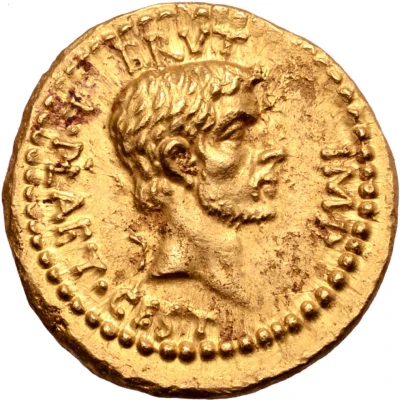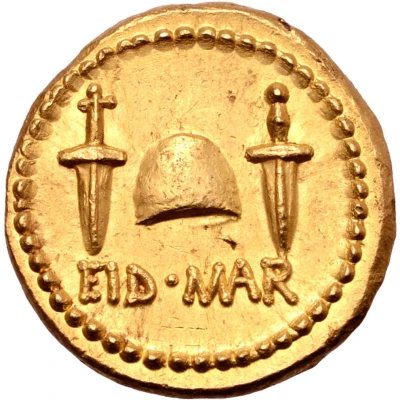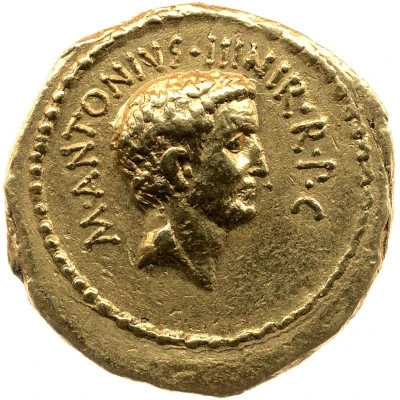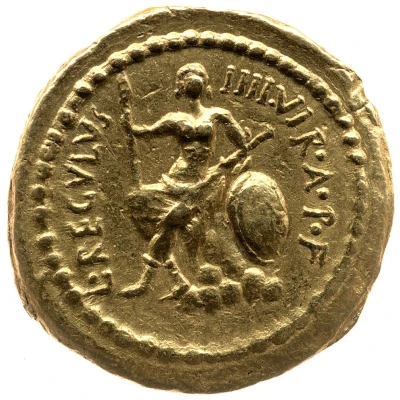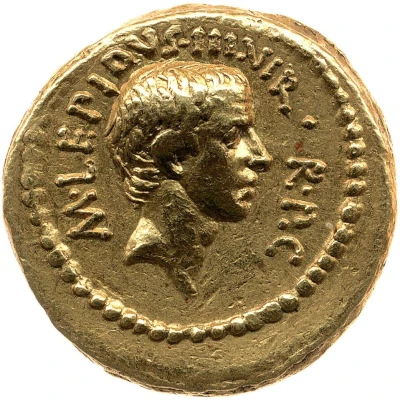
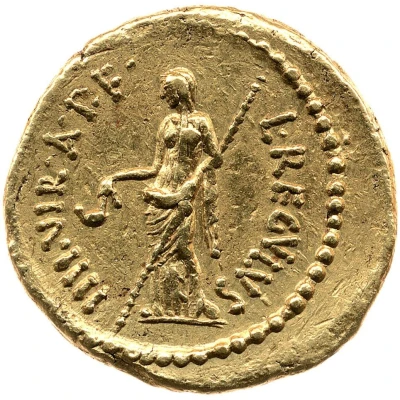

Aureus - Marcus Aemilius Lepidus M·LEPIDVS·III·VIR·R·P·C / L·REGVLVS IIII·VIR·A·P·F 42 BC
42 BC year| Gold | 8 g | 20.33 mm |
| Issuer | Rome › Roman Republic (509 BC - 27 BC) |
|---|---|
| Period | Republic (509 BC - 27 BC) |
| Type | Standard circulation coin |
| Year | 42 BC |
| Value | Aureus (25) |
| Currency | Denarius of 16 Asses (141 – 27 BC) |
| Composition | Gold |
| Weight | 8 g |
| Diameter | 20.33 mm |
| Shape | Round (irregular) |
| Technique | Hammered |
| Orientation | Variable alignment ↺ |
| Demonetized | Yes |
| Updated | 2024-10-06 |
| Numista | N#333248 |
|---|---|
| Rarity index | 100% |
Reverse
Aemilia (vestal) standing left, holding simpulum in right hand and transverse sceptre in left hand.
Border of dots.
Script: Latin
Lettering: L·REGVLVS IIII·VIR·A·P·F
Unabridged legend: Lucius Regulus Triumviri Ad Pecuniam Feriundam
Translation: Lucius Regulus, triumvir for the striking of the coinage
Comment
This piece ranks among the finest known portrait aurei of Lepidus, the doomed member of the Second Triumvirate (43-36 B.C.). His powerful colleagues, Marc Antony and Octavian, demonstrated early in their pact that Lepidus was the subordinate member, and they would continually remind him of it throughout the decade that the triumvirate remained intact. From the outset Lepidus was given a subsidiary role: as the brother-in-law of Brutus he was left behind in Italy when Antony and Octavian departed to face Brutus and Cassius at Philippi late in 42 B.C. In the aftermath Lepidus was almost expelled from the triumvirate, but instead he had his sphere of authority reduced to North Africa. Despite the help he offered Octavian in the Perusine War (41-40 B.C.) and in his campaign against Sextus Pompey in 36 B.C., Lepidus was denied the spoils of war. During the latter campaign, Lepidus landed 14 legions in Sicily to support from land the war Octavian was waging at sea against Sextus Pompey. But before a naval victory had been secured for Octavian, Lepidus demanded Sicily be added to his North African territories. Rather than granting his request, Octavian challenged Lepidus, whose legions quickly deserted to Octavian. The humbled triumvir was stripped of all authority except his title pontifex maximus, which he held until his death in exile in 13 or 12 B.C. Though Lepidus had struck coins as a moneyer in 61 B.C., his portrait occurs for the first time on aurei struck at a Gallic mint by Antony in 43 to celebrate the creation of the Second Triumvirate. In the following year, 42, Lepidus’ portrait occurs on aurei for the second (and final) time. In this case his aurei were struck at Rome by the moneyers C. Vibius Varus, L. Mussidius Longus, P. Clodius and L. Livineius Regulus.
Interesting fact
One interesting fact about the Aureus coin of Marcus Aemilius Lepidus is that it features a unique reverse design, depicting a jug and a lituus, which are symbols associated with the Roman goddess of fortune, Fortuna. This design was not commonly used on Roman coins, making it a distinctive feature of this particular coin.
